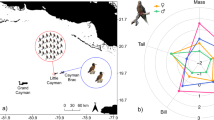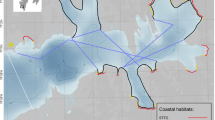Abstract
We studied the influence of the distribution of prey and hydrographic fronts on the spatial distribution of foraging Brunnich's guillemots (Uria lomvia) in Storfjorden, southeastern Svalbard in late July 1992. Two large breeding colonies, comprising a total of 540000 individuals, were located adjacent to the study area, and large numbers of Brünnich's gullemots from these colonies foraged within the area, as well as to the south, outside of Storfjorden. Within the study area, most guillemots foraged on the west side of the fjord, coincident with a weak subsurface front between warm Atlantic water, which penetrated Storfjorden from the south, and cold Arctic water. Food samples from the guillemots collected in the study area contained primarily crustaceans (Parathemisto spp. and Thysanoessa inermis) and polar cod Boreogadus saida. Acoustic observations of prey were differentiated into two classes of signals, which we interpreted as originating from aggregated and dispersed organisms. The numbers of foraging guillemots were strongly correlated with the strength of echoes of the aggregated type, whereas correlations with dispersed echoes were consistently weaker. The distribution of foraging guillemots showed no significant correlations with either horizontal or vertical gradients of physical properties of the water column. Our finding that guillemots respond differently to aggregated and dispersed prey has important implications both for the interpretation of past work on the foraging ecology of marine birds, and for the management of fisheries.
Similar content being viewed by others
References
Anderson LG, Jones EP, Lundgren R, Rudels B, Sehlstedt P-I (1988) Nutrient regeneration in cold, high salinity bottom water of the Arctic shelves. Cont Shelf Res 8:1345–1355
Bradstreet MSW, Brown RGB (1985) Feeding ecology of the Atlantic alcidae. In: Nettleship DN, Birkhead TM (eds) The Atlantic Alcidae. Academic Press. Orlando, Fla, pp 264–318
Coyle KO, Hunt GL, Decker MB, Weingartner TJ (1992) Murre foraging, epibenthic sound scattering and tidal advection over a shoal near St-George Island, Bering Sea. Mar Ecol Prog Ser 83:1–14
Decker MB (1995) Influences of oceanographic processes on seabird ecology. PhD Thesis. University of California, Irvine
Decker MB, Hunt GL Jr, Byrd GV Jr (1995) The relationships among sea-surface temperature, the abundance of juvenile walleye pollock (Theragra chalcogramma), and the reproductive performance and diets of seabirds at the Pribilof Islands, southeastern Bering Sea. In: Beamish RJ (ed) Climate change and northern fish populations. Can Spec Publ Fish Aquat Sci 121: 425–437
Duffy DC, Jackson S (1986) Diet studies of seabirds: a review of methods. Colon Waterbirds 9:1–17
Elphick CS, Hunt GL Jr (1993) Variations in the distributions of marine birds with water mass in the northern Bering Sea. Condor 95:33–44
Fiedler PC, Bernard HJ (1987) Tuna aggregation and feeding near fronts observed in satellite imagery. Cont Shelf Res 7:871–881
Franks PJS (1992) Sink or swim: accumulation of biomass at fronts. Mar Ecol Prog Ser 82:1–12
Fretwell SD, Lucas HL Jr (1970) On territorial behavior and other factors influencing habitat distribution in birds. Acta Biotheor 19:16–36
Frost KJ, Lowry LF (1981) Trophic importance of some marine gadids in northern Alaska and their body-otolith size relationships. Fish Bull US 79:187–192
Haney JC (1986) Seabird affinities for Gulf Stream frontal eddies: responses of mobile marine consumers to episodic upwelling. J Mar Res 44:361–384
Hunt GL Jr, Harrison NM (1990) Foraging habitat and prey taken by Least Auklets at King Island, Alaska. Mar Ecol Prog Ser 65:141–150
Hunt GL Jr, Harrison NM, Cooney RT (1990a) The influence of hydrographic structure and prey abundance on foraging Least Aaklets. Stud Avian Biol 14:7–22
Hunt GL, Heinemann D, Veit RR, Heywood RB, Everson I (1990b) The distribution, abundance and community structure of marine birds in southern Drake Passage and Bransfield Strait, Antarctica. Cont Shelf Res 10:243–257
Hunt GL Jr, Heinemann D, Everson I (1992) Distributions and predator-prey interactions of macaroni penguins, Antarctic fur seals, and Antarctic krill near Bird Island, South Georgia. Mar Ecol Prog Ser 86:15–30
Kinder TH, Hunt GL Jr, Schneider DC, Schumacher JD (1983) Correlations between seabirds and oceanic fronts around the Pribilof Islands, Alaska. Estuarine Coastal Shelf Sci 16:209–219
Mehlum F, Bakken V (1994) Seabirds in Svalbard: status, recent changes and management. In: Nettleship DN, Burger J, Gochfeld M (eds) Seabirds on islands: threats, case studies and action plans. BirdLife Conservation Series, no 1, Bird Life International, Cambridge, pp 155–171
Mehlum F, Gabrielsen GW (1993) The diet of high arctic seabirds in coastal and ice-covered pelagic areas near the Svalbard archipelago. Polar Res 11:1–20
Milinski M, Parker GA (1991) Competition for resources. In: Krebs JR, Davies NB (eds) Behavioural ecology, an evolutionary approach, 3rd edn. Blackwell, London, pp 137–168
Podestá GP, Browder JA, Hoey JJ (1993) Exploring the association between swordfish catch rates and thermal fronts on U.S. longline grounds in the western Atlantic. Cont Shelf Res 13:253–277
Quadfasel D, Rudels B, Kurz K (1988) Outflow of dense water from a Svalbard fjord into Fram Strait. Deep Sea Res 35:1143–1150
Schneider DC, Harrison NM, Hunt GL Jr (1987) Variation in the occurrence of marine birds at fronts in the Bering Sea. Estuarine Coastal Shelf Sci 25:135–141
Schneider DC, Harrison NM, Hunt GL Jr (1990) Seabird diets at a front near the Pribilof Islands, Alaska. Stud Avian Biol 14:61–66
Tasker ML, Hope Jones P, Dixon T, Blake BF (1984) Counting seabirds from ships: a review of methods employed and a suggestion for a standardized approach. Auk 101:567–577
Wishner KF, Durbin E, Durbin A, Macauly M, Winn H, Kenny N (1988) Copepod patches and right whales in the Great South Channel off New England. Bull Mar Sci 43:825–844
Author information
Authors and Affiliations
Corresponding author
Additional information
This is Norwegian Polar Institute Contribution No. 304
Rights and permissions
About this article
Cite this article
Mehlum, F., Hunt, G.L., Klusek, Z. et al. The importance of prey aggregations to the distribution of Brünnich's guillemots in Storfjorden, Svalbard. Polar Biol 16, 537–547 (1996). https://doi.org/10.1007/BF02329050
Received:
Accepted:
Issue Date:
DOI: https://doi.org/10.1007/BF02329050




